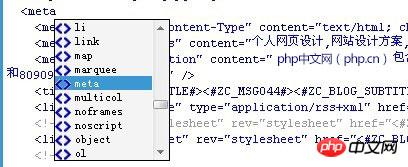CSS is the style, DIV is the layer. DIV+CSS is the website standard (web standard), usually to illustrate the difference from the table positioning method in the HTML web design language. Because in the XHTML website design standard, it is no longer Use table positioning technology, but use DIV+CSS to achieve various positioning. Many students who do website development start from the web front-end. So how to learn DIV+CSS from scratch?
1. Learn the HTML language, and then learn DIV+CSS with ease.
If you understand HTML syntax, you can see through 80% of the websites in the world. HTML language is easy to learn, and you must memorize some commonly used codes. Because of tools like Dreamweaver that help generate HTML code, many people ignore the learning of HTML. After learning HTML, the most basic language in the Internet, When learning DIV+CSS, you will find: It turns out that DIV+CSS is just like that, a piece of cake.
Recommended tutorial:
HTML online learning manual: //m.sbmmt.com/course/27.html
htmlOnline learning Video tutorial: //m.sbmmt.com/course/list/11.html
php.cn Original html5 video tutorial: http://www.php .cn/course/372.html
2. Use Dreamweaver’s code mode to write DIV and CSS.
For beginners in web design, it is difficult to write code directly using Notepad, Notepad and other tools. Because Dreamweaver's code mode has a prompt function, it can ensure the correctness of the syntax written. And you can write unfamiliar grammar correctly at once.
As shown in the figure: the functions provided by DW when writing p and html.

The CSS visual editing function on the right side of the DW toolbar when writing CSS.

When I learn DIV+CSS I learned it from Dreamweaver's code model. It may not be the best, but it is very practical. (Dreamweaver tool download)
Recommended tutorial:
CSS online learning manual: //m.sbmmt.com/course/45.html
CSS online learning video tutorial: //m.sbmmt.com/course/list/12.html
php.cn Dugu Jiubian ( 2) - CSS video tutorial: //m.sbmmt.com/course/373.html
3. Develop good writing habits.
Having good living habits means that the person is good at living, and having good CSS writing habits means that the person is rigorous in doing things. There are many recommended specifications on the Internet when writing CSS, such as menu for menu, copyright (CoryRight) for copyright, footer for bottom, etc. The writing order is generally: display attribute-self attribute-text attribute. Of course, there are no hard and fast rules for these, but it is not a bad thing to follow some unwritten rules. This will make the code you write easier for others to understand, and search engines will like it more.
4. Only when the purpose is clear and the results are clear can the process be the most efficient and will not be easily disturbed or changed in direction.
CSS+DIV Practical Combat: Developing a Personal Blog Video Tutorial: //m.sbmmt.com/course/190.html
Recommended related articles:
Web front-end learning route: Quick introduction to WEB front-end development
What do you need to learn to become an excellent front-end engineer?




